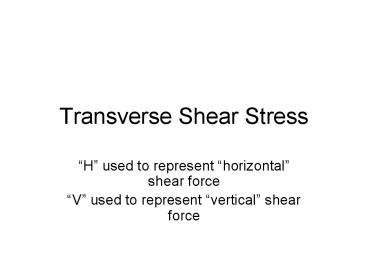Transverse Shear Stress - PowerPoint PPT Presentation
1 / 15
Title:
Transverse Shear Stress
Description:
... used to represent 'vertical' shear force. Here four books that are not. connected are deformed. In b) just a load is applied and it. causes a moment, but shear ... – PowerPoint PPT presentation
Number of Views:390
Avg rating:3.0/5.0
Title: Transverse Shear Stress
1
Transverse Shear Stress
- H used to represent horizontal shear force
- V used to represent vertical shear force
2
Here four books that are not connected are
deformed In b) just a load is applied and
it causes a moment, but shear stress Cannot be
transferred between the boards. In c) the ends
are constrained and a moment is applied. If the
beam were solid and P or M were applied shear
stress would occur or horizontal planes
3
Here the wood beam is in four point bending and
the shear force causes a shear stress that causes
the wood to fail in shear.
4
Here the bending moment and vertical shear force
are shown on the right.
5
The bending moment causes the ?x, while the shear
force causes the ?xy, but there is also the ?yx
which is associated with a horizontal shear force
H.
6
The shear stress due to the shear force varies
across the cross-section. Here is the variation
for a rectangular cross-section.
Corresponding V
7
Make two parallel vertical cuts a distance ?x
apart near C, then make a horizontal cut
8
?H
t
Beam is solid so area (?x)t
9
Shear force Area supporting the shear force,
here nails
If ?x s, 1 nail, if ?x 2s then 2 nails
10
Shear force Area supporting the shear force,
here bolts
11
Here ?x is not needed, only t. If our horizontal
cut is here
t 1 in.
and here t 4 in.
12
To determine the shear stress it is also
necessary to properly determine Q!
Q(5010) (20)(100) mm3
Q (3h/4)(b)(h/4)
Q (h/4)(b)(h/2)
h
Note- these Qs are for shear stress at the
position of the horizontal cut
13
6.2
14
6.7
15
6.24
Use V M diagrams to determine Vmax between A
and 12 kips Then determine the largest VQ/It for
a point on the cross-section.































